
MySQL Technical Interview Questions: MySQL is a popular open-source Relational Database Management System (RDBMS) that is widely used by businesses of all sizes. Whether you are a fresher looking to start your career in MySQL or an experienced professional, it’s essential to be well-prepared for technical interviews. The Latest MySQL Interview Questions can be challenging, covering various topics like database design, query optimization, data modeling, and many more.
★★ Latest Technical Interview Questions ★★
MySQL Interview Questions and Answers
In this article, we have compiled a list of the Top 100 MySQL Interview Questions and Answers, including MySQL Technical Interview Questions, and MySQL Interview Questions for Freshers, to help you ace your MySQL interview.
Top 100 MySQL Interview Questions and Answers
1. What is MySQL?
Answer: MySQL is an open-source relational database management system that is based on the SQL language.
2. What are the advantages of MySQL?
- MySQL is compatible with various operating systems, making it flexible.
- Performance is a major focus for MySQL.
- In the past, MySQL lacked advanced features like subqueries, views, and stored procedures at the enterprise level.
- Full-text indexing and searching are supported in MySQL.
- Query caching is available in MySQL to improve its speed.
- Replication is a useful feature of MySQL that allows duplication of a server for various benefits.
- MySQL has configuration and security options to ensure its proper functioning and protection against threats.
3. What are some of the common MySQL commands?
| Command | Action |
|---|---|
| ALTER | To alter a database or table |
| BACKUP | To back-up a table |
| \c | To cancel Input |
| CREATE | To create a database |
| DELETE | To delete a row from a table |
| DESCRIBE | To describe a table’s columns |
| DROP | To delete a database or table |
| EXIT(ctrl+c) | To exit |
| GRANT | To change user privileges |
| HELP (\h, \?) | Display help |
| INSERT | Insert data |
| LOCK | Lock table(s) |
| QUIT(\q) | Same as EXIT |
| RENAME | Rename a Table |
| SHOW | List details about an object |
| SOURCE | Execute a file |
| STATUS (\s) | Display the current status |
| TRUNCATE | Empty a table |
| UNLOCK | Unlock table(s) |
| UPDATE | Update an existing record |
| USE | Use a database |
4. What are some of the features of MySQL?
Answer: MySQL includes support for transactions, triggers, views, stored procedures, and many other advanced features that make it a powerful and flexible database management system.
5. How do you create a database in MySQL?
Answer: To create a database in MySQL, use the CREATE DATABASE command followed by the name of the database.
6. How do you create a new MySQL database?
Answer:
| CREATE DATABASE database_name; |
7. How do you create a table in MySQL?
Answer: To create a table in MySQL, use the CREATE TABLE command followed by the name of the table and the list of columns.
8. What is a primary key in MySQL?
Answer: A primary key is a unique identifier for a record in a table. It is used to ensure that each record in the table can be uniquely identified.
9. What are the differences between MySQL and SQL Server?
| Criteria | MySQL | SQL Server |
| Developed by | Oracle | Microsoft |
| Programmed in | C and C++ | Mainly C++, but some parts in C |
| Platforms | Supports many platforms | Supports only Linux and Windows |
| Syntax | Complex Syntax | Simpler and easy-to-use syntax |
10. How do you add a column to a table in MySQL?
Answer: To add a column to a table in MySQL, use the ALTER TABLE command followed by the name of the table and the new column definition.
11. What is a foreign key in MySQL?
Answer: A foreign key is a field in one table that refers to the primary key of another table. It is used to establish a relationship between two tables.
12. How do you create a new MySQL table?
Answer:
| CREATE TABLE table_name (column1 datatype1, column2 datatype2, …); |
13. What is a stored procedure in MySQL?
Answer: A stored procedure is a set of SQL statements that are stored in the database and can be executed as a single unit.
14. What are the differences between a primary key and a foreign key?
| Primary Key | Foreign Key |
| It helps in the unique identification of data in a database | It helps establish a link between tables |
| There can be only one primary key for a table | There can be more than one foreign key for a table |
| Primary key attributes cannot have duplicate values in a table | Duplicate values are acceptable for a foreign key |
| Null values are not acceptable | Null values are acceptable |
| We can define primary key constraints for temporarily created tables | It cannot be defined for temporary tables |
| The primary key index is automatically created | The index is not created automatically |
15. How do you create a trigger in MySQL?
Answer: To create a trigger in MySQL, use the CREATE TRIGGER command followed by the name of the trigger, the table it applies to, and the SQL statements that define it.
16. What is a cursor in MySQL?
Answer: A cursor in MySQL is a mechanism for iterating over the rows in a result set. It allows you to process each row in turn and perform operations on it.
17. How do you create a cursor in MySQL?
Answer: To create a cursor in MySQL, use the DECLARE CURSOR command followed by the name of the cursor and the SELECT statement that defines the result set.
18. What is a transaction in MySQL?
Answer: A transaction in MySQL is a set of SQL statements that are executed as a single unit. It allows you to ensure that a group of changes to the database are all executed successfully or rolled back if any one of them fails.
19. What is normalization in MySQL?
Answer: Normalization in MySQL is the process of organizing data in a database to reduce redundancy and dependency.
20. What is the difference between the primary key and the candidate key?
- In MySQL, the primary key is utilized to uniquely identify each row of a table. A table can have only one primary key.
- Candidate keys, on the other hand, can be used to reference foreign keys. The primary key is one of the candidate keys that can be used for this purpose.
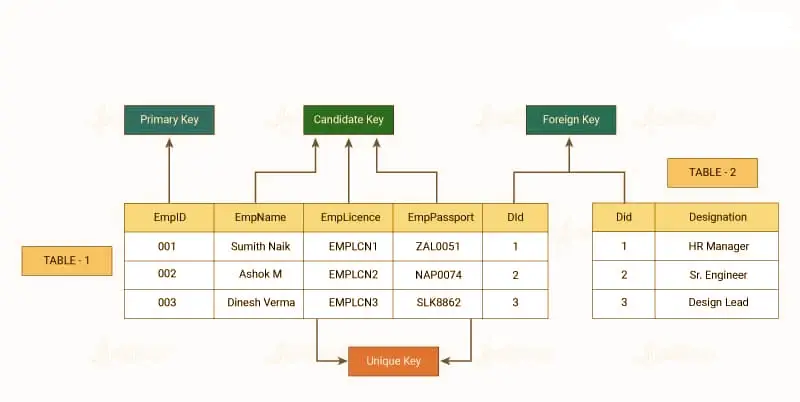
21. How do you normalize a database in MySQL?
Answer: To normalize a database in MySQL, you need to identify the dependencies between the data elements and organize them into tables that follow certain rules.
22. When should denormalization be used in MySQL?
Answer: Denormalization should only be used in MySQL when there is a clear performance benefit that outweighs the cost of introducing redundancy and complexity into the database.
23. What is indexing in MySQL?
Answer: Indexing in MySQL is the process of creating an index on a column or set of columns in a table in order to improve the performance of queries that use those columns.
24. How do you insert data into a MySQL table?
Answer:
| INSERT INTO table_name (column1, column2, …) VALUES (value1, value2, …); |
25. How do you create an index in MySQL?
Answer: To create an index in MySQL, use the CREATE INDEX command followed by the name of the index, the name of the table, and the name of the column or columns to be indexed.
26. What is a full-text index in MySQL?
Answer: A full-text index in MySQL is an index that allows you to perform text-based searches on the contents of a column or set of columns.
27. How do you create a full-text index in MySQL?
Answer: To create a full-text index in MySQL, use the CREATE FULLTEXT INDEX command followed by the name of the index, the name of the table, and the name of the column or columns to be indexed.
28. What is a query in MySQL?
Answer: A query in MySQL is a request for data from a database that matches certain criteria.
29. How do you write a basic SELECT query in MySQL?
Answer: To write a basic SELECT query in MySQL, use the SELECT command followed by the name of the column or columns you want to retrieve and the name of the table you want to retrieve them from.
30. What is a subquery in MySQL?
Answer: A subquery in MySQL is a query that is embedded inside another query. It is used to retrieve data that is then used as input to the outer query.
31. How do you write a subquery in MySQL?
Answer: To write a subquery in MySQL, enclose the inner query in parentheses and use it as input to the outer query.
32. What is a join in MySQL?
Answer: A join in MySQL is a mechanism for combining data from two or more tables based on a common column or set of columns.
33. What are the different types of joins in MySQL?
Answer: The different types of joins in MySQL include inner joins, left joins, right joins, and full outer joins.
34. What is an inner join in MySQL?
Answer: An inner join in MySQL is a join that returns only the rows that have matching values in both tables being joined.
35. What is a left join in MySQL?
Answer: A left join in MySQL is a join that returns all the rows from the left table and the matching rows from the right table. If there are no matching rows in the right table, the result will contain NULL values for those columns.
36. How do you update data in a MySQL table?
Answer:
| UPDATE table_name SET column1 = value1, column2 = value2, … WHERE condition; |
37. How do you start a transaction in MySQL?
Answer: To start a transaction in MySQL, use the START TRANSACTION command.
38. How do you commit a transaction in MySQL?
Answer: To commit a transaction in MySQL, use the COMMIT command.
39. How do you rollback a transaction in MySQL?
Answer: To rollback a transaction in MySQL, use the ROLLBACK command.
40. What is the difference between a DELETE statement and a TRUNCATE statement in MySQL?
Answer: A DELETE statement in MySQL removes individual rows from a table based on a certain condition, while a TRUNCATE statement removes all rows from a table.
41. What is the difference between a UNION statement and a UNION ALL statement in MySQL?
Answer: A UNION statement in MySQL combines the result sets of two or more SELECT statements into a single result set, removing any duplicates. A UNION ALL statement also combines the result sets of two or more SELECT statements, but does not remove duplicates.
42. What is the difference between a primary key and a unique key in MySQL?
Answer: A primary key in MySQL is a column or set of columns that uniquely identifies each row in a table. A unique key in MySQL is a column or set of columns that does not allow duplicate values, but does not necessarily identify each row uniquely.
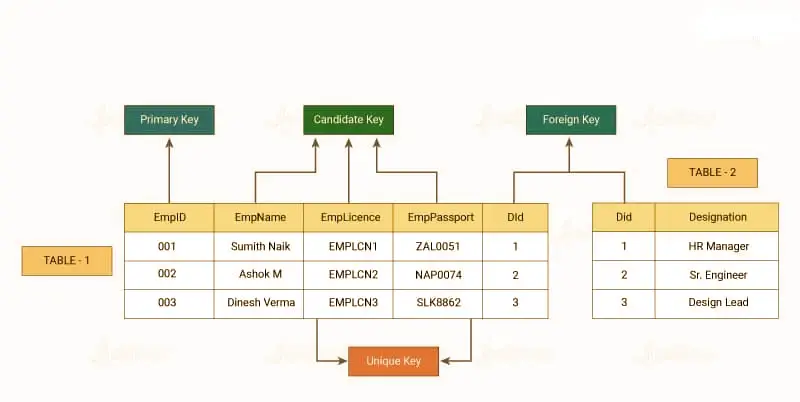
43. What is the difference between a CHAR data type and a VARCHAR data type in MySQL?
Answer: A CHAR data type in MySQL is a fixed-length string, while a VARCHAR data type is a variable-length string.
44. What is the difference between a FLOAT data type and a DOUBLE data type in MySQL?
Answer: A FLOAT data type in MySQL is a single-precision floating-point number, while a DOUBLE data type is a double-precision floating-point number.
45. What is the difference between a TIMESTAMP data type and a DATETIME data type in MySQL?
Answer: A TIMESTAMP data type in MySQL stores the number of seconds since the Unix epoch (January 1, 1970), while a DATETIME data type stores a date and time in a more human-readable format.
46. What is a database index?
Answer: An index in MySQL is a data structure that improves the speed of data retrieval operations on a table.
47. What are the benefits of database indexing?
Answer: The benefits of database indexing in MySQL include:
- Faster data retrieval: Indexing can significantly speed up data retrieval operations, particularly for large tables.
- Improved query performance: Queries that use indexed columns as filters can be executed much more quickly than those that do not.
- Reduced disk I/O: Indexing can reduce the amount of disk I/O required to retrieve data, which can improve overall system performance.
- Improved concurrency: Indexing can improve concurrency by reducing the amount of time that database locks are held during data retrieval operations.
48. What is denormalization in MySQL?
Answer: Denormalization is the process of intentionally introducing redundancy into a database in order to improve performance. This is often done by adding redundant columns to a table or by duplicating data in multiple tables.
49. What is a self-join in MySQL?
Answer: A self-join in MySQL is a join that is performed on a single table. This is done by creating two or more aliases for the same table and joining them together using different columns.
50. What is the difference between a left join and a right join in MySQL?
Answer: A left join in MySQL returns all rows from the left table and matching rows from the right table. A right join returns all rows from the right table and matching rows from the left table.
51. What is the difference between a correlated subquery and a non-correlated subquery in MySQL?
Answer: A correlated subquery in MySQL is a subquery that references columns from the outer query. A non-correlated subquery does not reference columns from the outer query.
52. What is a compound key in MySQL?
Answer: A compound key in MySQL is a key that is made up of two or more columns. The combination of columns must be unique.
53. What is a temporary table in MySQL?
Answer: A temporary table in MySQL is a table that is created and used for a single session or query. Temporary tables are automatically dropped when the session or query ends.
54. How do you delete data from a MySQL table?
Answer:
| DELETE FROM table_name WHERE condition; |
55. What is the difference between an inner join and an outer join in MySQL?
Answer: An inner join in MySQL returns only the rows that have matching values in both tables. An outer join returns all rows from both tables, and includes null values for columns where there is no match.
56. What is a full outer join in MySQL?
Answer: A full outer join in MySQL returns all rows from both tables, and includes null values for columns where there is no match.
57. What is a cross join in MySQL?
Answer: A cross join in MySQL returns the Cartesian product of the two tables being joined. This means that every row in the first table is joined with every row in the second table.
58. How do you select all data from a MySQL table?
Answer:
| SELECT * FROM table_name; |
59. What is a clustered index in MySQL?
Answer: A clustered index in MySQL is an index that determines the physical order of data in a table. Tables can have only one clustered index.
60. What is a non-clustered index in MySQL?
Answer: A non-clustered index in MySQL is an index that does not determine the physical order of data in a table. Tables can have multiple non-clustered indexes.
61. How do you select specific columns from a MySQL table?
Answer:
| SELECT column1, column2, … FROM table_name; |
62. What are the Numeric Data Types in MySQL?
Answer:
| Type Name | Meaning |
|---|---|
| TINYINT | Very Small Integer |
| SMALLINT | Small Integer |
| MEDIUMINT | Medium-sized Integer |
| INT | Standard Integer |
| BIGINT | Large Integer |
| DECIMAL | Fixed-point number |
| FLOAT | Single-precision floating-point number |
| DOUBLE | Double-precision floating-point number |
| BIT | Bit-field |
63. What is the difference between the CHAR and VARCHAR data types in MySQL?
Answer: The CHAR data type in MySQL is used to store fixed-length character strings. VARCHAR is used to store variable-length character strings. VARCHAR is typically more space-efficient than CHAR, but may require more processing time when inserting or updating data.
64. How do you select data from a MySQL table based on a condition?
Answer:
| SELECT * FROM table_name WHERE condition; |
65. How do you join two MySQL tables?
Answer:
| SELECT * FROM table1 JOIN table2 ON table1.column = table2.column; |
66. How do you group data in a MySQL query?
Answer:
| SELECT column1, SUM(column2) FROM table_name GROUP BY column1; |
67. What is a foreign key constraint in MySQL?
Answer: A foreign key constraint in MySQL is a rule that enforces a relationship between two tables. The foreign key column in one table references the primary key column in another table.
68. What is the difference between a primary key constraint and a unique key constraint in MySQL?
Answer: A primary key constraint in MySQL is used to enforce the uniqueness of a column or set of columns, and to identify each row in the table. A unique key constraint is used to enforce the uniqueness of a column or set of columns, but does not necessarily identify each row in the table.
69. How do you order data in a MySQL query?
Answer:
| SELECT * FROM table_name ORDER BY column1 ASC/DESC; |
70. How do you limit the number of rows returned in a MySQL query?
Answer:
| SELECT * FROM table_name LIMIT 10; |
71. What is the purpose of the EXPLAIN statement in MySQL?
Answer: The EXPLAIN statement in MySQL is used to analyze and optimize the performance of SQL statements. The statement provides information on how MySQL executes the statement and can be used to identify potential performance issues.
72. What is a database index in MySQL?
Answer: A database index in MySQL is a data structure that is used to improve the performance of database queries. Indexes can be created on one or more columns in a table and can be used to speed up searches, joins, and other operations.
73. How do you calculate the average value of a column in a MySQL table?
Answer:
| SELECT AVG(column_name) FROM table_name; |
74. How do you count the number of rows in a MySQL table?
Answer:
| SELECT COUNT(*) FROM table_name; |
75. What is a natural join in MySQL?
Answer: A natural join in MySQL is a join that is performed on columns with the same name in both tables. The join condition is implicit.
76. What is a self-referential foreign key in MySQL?
Answer: A self-referential foreign key in MySQL is a foreign key that references the same table. This is often used to create hierarchical relationships within a single table.
77. How do you find the maximum value in a column in a MySQL table?
Answer:
| SELECT MAX(column_name) FROM table_name; |
78. How do you find the minimum value in a column in a MySQL table?
Answer:
| SELECT MIN(column_name) FROM table_name; |
79. What is a right join in MySQL?
Answer: A right join in MySQL is a join that returns all the rows from the right table and the matching rows from the left table. If there are no matching rows in the left table, the result will contain NULL values for those columns.
80. What is the difference between the MyISAM and InnoDB storage engines in MySQL?
Answer: The MyISAM storage engine in MySQL is a simple, fast storage engine that is well-suited for read-heavy applications. The InnoDB storage engine is a more complex storage engine that supports transactions and is well-suited for write-heavy applications.
81. How do you create an index on a MySQL table?
Answer:
| CREATE INDEX index_name ON table_name(column_name); |
82. What are the common MySQL functions?
Answer:
Common MySQL functions are as follows:
- NOWO: The function for returning the current date and time as a single value
- CURRDATEO: The function for returning the current date or time
- CONCAT (X, Y): The function to concatenate two string values creating a single string output
- DATEDIFF (X, Y): The function to determine the difference between two dates
83. What is replication in MySQL?
Answer: Replication in MySQL is the process of copying data from one database to another. This can be used to distribute data across multiple servers for load balancing or fault tolerance.
84. How do you create a stored procedure in MySQL?
Answer:
| CREATE PROCEDURE procedure_name(parameters) BEGIN — code goes here END; |
85. How do you create a view in MySQL?
Answer:
| CREATE VIEW view_name AS SELECT column1, column2 FROM table_name WHERE condition; |
86. How do you grant privileges to a user in MySQL?
Answer:
| GRANT privilege_name ON database_name.table_name TO ‘username’@’localhost’; |
87. Explain the logical architecture of MySQL
Answer:
- The first layer of MySQL encompasses essential services required by client/server tools and servers, including connection management, security, and authentication.
- The second layer of MySQL is where much of the database management system’s intelligence resides. It comprises the code responsible for analyzing, parsing, optimizing queries, and caching, along with all the built-in functions.
- The third layer of MySQL comprises storage engines that are accountable for storing and retrieving data from the database.
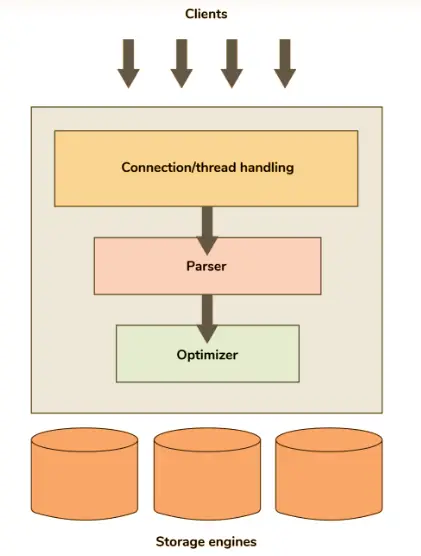
88. What is a view in MySQL?
Answer: A view in MySQL is a virtual table that is based on the result of a SELECT statement. Views can be used to simplify complex queries, and can be used in place of tables in most SQL statements.
89. What is a trigger in MySQL?
Answer: A trigger in MySQL is a set of actions that are automatically executed when a specified event occurs. Triggers can be used to enforce business rules or data integrity constraints.
90. What are the TRIGGERS that can be used in MySQL tables?
Below are TRIGGERS that are allowed in MySQL:
- BEFORE INSERT
- AFTER INSERT
- BEFORE UPDATE
- AFTER UPDATE
- BEFORE DELETE
- AFTER DELETE
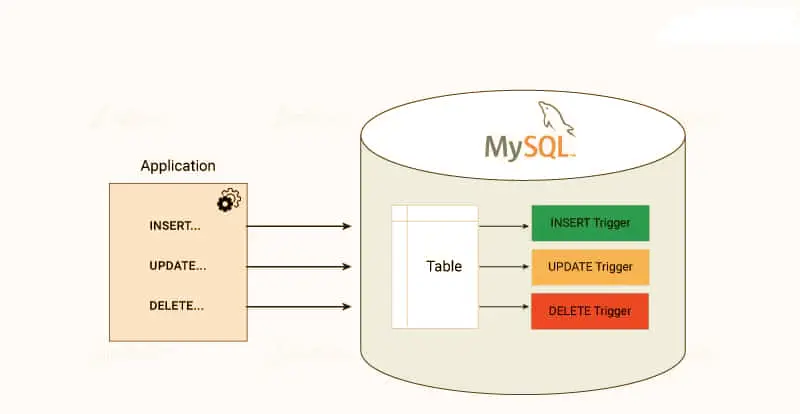
91. What is a deadlock in MySQL?
Answer: A deadlock in MySQL is a situation where two or more transactions are waiting for each other to release locks on resources. This can result in a situation where none of the transactions can proceed.
92. What is the difference between the UPDATE and DELETE commands in MySQL?
Answer: The UPDATE command in MySQL is used to modify existing data in a table. The DELETE command is used to remove data from a table.
93. What is the difference between the IS NULL and IS NOT NULL operators in MySQL?
Answer: The IS NULL operator in MySQL is used to test whether a column contains a null value. The IS NOT NULL operator is used to test whether a column does not contain a null value.
94. What is the difference between the COUNT(*) and COUNT(column_name) functions in MySQL?
Answer: The COUNT(*) function in MySQL is used to count the number of rows in a table, regardless of whether any specific column contains a null value. The COUNT(column_name) function is used to count the number of non-null values in a specific column.
95. What is an access control list?
Answer:
- To prevent data loss and ensure secure access, organizations establish a set of permissions that are associated with different data objects. This set of permissions is referred to as an access control list (ACL).
- The ACL serves as the foundation for the server’s security and can help resolve connection issues for users. These lists are also referred to as grant tables and are cached by MySQL. When a user executes a command, MySQL verifies the user for authentication and grants permissions in a particular sequence.
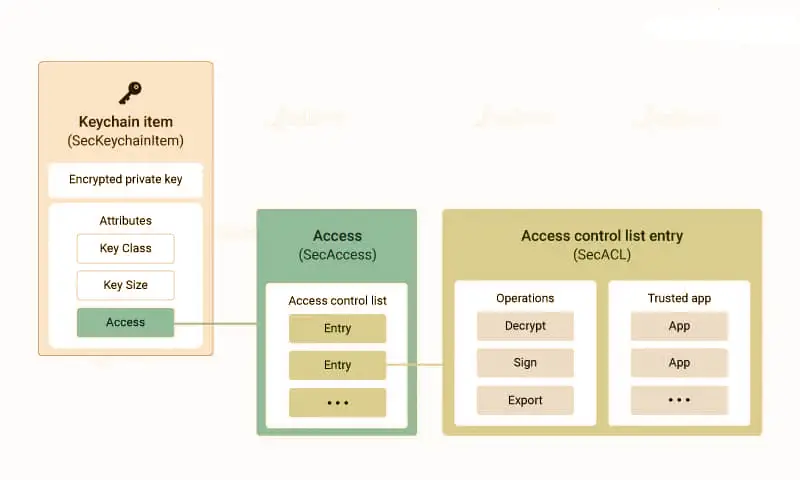
96. What is the difference between the INNER JOIN and OUTER JOIN clauses in MySQL?
Answer: The INNER JOIN clause in MySQL is used to return only the rows that have matching values in both tables being joined. The OUTER JOIN clause is used to return all the rows from one table and only the matching rows from the other table being joined.
97. What is the difference between a LEFT JOIN and a RIGHT JOIN in MySQL?
Answer: A LEFT JOIN in MySQL returns all the rows from the left table and only the matching rows from the right table being joined. A RIGHT JOIN returns all the rows from the right table and only the matching rows from the left table being joined.
98. What is the difference between a UNION and a UNION ALL operation in MySQL?
Answer: A UNION operation in MySQL is used to combine the results of two or more SELECT statements into a single result set. The UNION ALL operation is similar, but it includes duplicate rows in the result set.
99. What is the difference between a clustered index and a non-clustered index in MySQL?
Answer: A clustered index in MySQL is an index that determines the physical order of the rows in a table. A non-clustered index is an index that does not affect the physical order of the rows in a table.
100. What is a database constraint in MySQL?
Answer: A database constraint in MySQL is a rule that is enforced by the database to ensure data integrity. Constraints can be used to ensure that data is unique, non-null, or within a specific range of values.
For those seeking to enhance their understanding of MySQL, the Top 100 MySQL Interview Questions and Answers provide a valuable resource. To gain additional knowledge, follow freshersnow.com.



